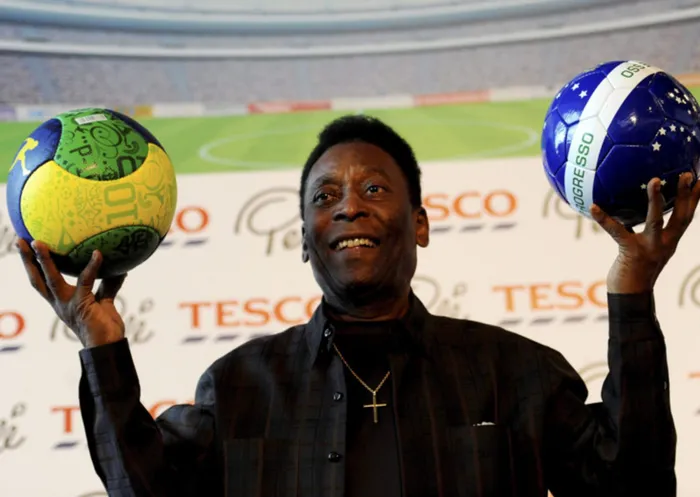How Pelé made the beautiful game of soccer beautiful in America

Picture: Photo: BARTLOMIEJ ZBOROWSKI
By Bill Saporito
The great Brazilian soccer star Pelé, who died Thursday at 82, made his unlikely American debut with the New York Cosmos of the North American Soccer League on June 15, 1975. His mission was to make soccer a major sport. Those of us who showed up at a drab and dingy Downing Stadium in New York City that day already knew that soccer was a major sport.
Just not here.
If you played soccer in the United States in the 1970s, you were part of a seething minority of true believers; we deeply resented the other football, while desperately wanting our football to be just as popular. Soccer had been played in the United States for more than a century before Pelé arrived, yet it was still considered a "foreign" sport. (As if the Founding Fathers had invented golf.) You couldn't watch Pelé play in World Cup matches on live television. (Heck, you could never watch any matches.) You had to go to movie theaters and pay to watch "satellite transmission."
Pelé was our apostle; we prayed that he would make soccer matter in a stick-and-ball nation. His astonishing skill demanded attention, and his humility and personality made him likable and approachable. Today, pro soccer is thriving; franchises that were once practically given away now fetch millions. And the popularity of the U.S. men's and women's national teams has never been greater. The U.S. television audience for the recent World Cup final nearly drew what networks call "NFL numbers."
We can't credit Pelé with all of that, but we can applaud him for being not only the game's greatest player but also its greatest salesman. He played for the Cosmos for three years, leading a traveling soccer carnival across the country, performing before the kind of crowds that were unheard of for the sport.
What people came to see was a smallish athlete with outsize ball skills. Like Michael Jordan, Pelé could amaze with his sheer athleticism and his ability to change speeds to beat opponents off the dribble. Like Wayne Gretzky, Pelé transfixed fans with his ability to anticipate the play and get there before the ball. He always seemed to have an extra move that left defenders confused and embarrassed.
But unlike MJ and the Great One, Pelé was subject to horrific abuse off and on the field. Hostile sports fans called him appalling names, and it's shocking to watch the clips of opposing players whacking him without pretense of going for the ball - or the ball being anywhere near him. In the 1962 and 1966 World Cups, he was kicked into submission and forced out of the tournament. By the 1970 World Cup, won by Brazil in spectacular fashion, FIFA had established the yellow and red card system that helped to protect talented players like Pelé from the hacks.
Pelé's New York Cosmos were a prototype of sorts for today's glamour teams such as Manchester City and Paris Saint-Germain. The Cosmos had a seemingly unlimited budget, courtesy of Warner Communications, the entertainment conglomerate that owned them. The team was founded and run by Ahmet and Nesuhi Ertegun, Turkish-born, soccer-mad brothers - raised in Washington, D.C. - who ran Atlantic Records, the conglomerate's highly profitable music business. Another Warner employee, Bugs Bunny, was a sideline regular.
By the time Pelé retired from soccer, the Cosmos was filling the 80,000-seat Giants Stadium. We proudly wore the green-and-white Cosmos jersey to games, especially Pele's famous No. 10, just like we did Giants blue.
True, even Pelé couldn't close the deal. The North American Soccer League folded in the mid-80s because the all-star show that the Cosmos staged in New York wasn't sustainable in Minneapolis and Tampa. But Pelé had made the case for the hesitant; high schools began to sponsor the sport, and then came the explosion in kid leagues, and soon there was a creature known in politics as the soccer mom. The wildly successful 1994 World Cup, staged in the United States, confirmed the game's arrival. In 1999, when the U.S. women's team beat Denmark 3-0 before a sellout crowd at Giants stadium, the American players were stunned by the immense reception.
Soccer fans now have to take the good with the bad. In Kaiserslautern, Germany, in the 2006 World Cup, I sat among American fans to watch the U.S. men's national team draw 1-1 with Italy, a surprising outcome in a surprisingly vicious match in which two Americans were shown red cards. The American fans howled with displeasure when Eddie Pope was dismissed early in the second half. One fan launched a plastic bottle of Budweiser onto the pitch. Part of me was mortified at this thuggish display; but part of me cheered the fact that the match mattered so much to the Yanks. We now belonged to the global game, for better or worse.
Today, I have to chuckle a bit when I hear people who talk soccer as much as they do football: Is Man City better than Real Madrid? Is Messi better than Maradona? Can England beat the United States? (No.)
And in places like Austin and Portland, Seattle and Atlanta, Major League Soccer fans have created a soccer culture every bit as rich as that of England, Italy or Germany. All we're missing now is the odd riot.
That was unthinkable when Pelé landed here 47 years ago. He made the beautiful game beautiful here. Thank you, O Rei.
Bill Saporito is editor at large at Inc.
This article was first published in The Washington Post